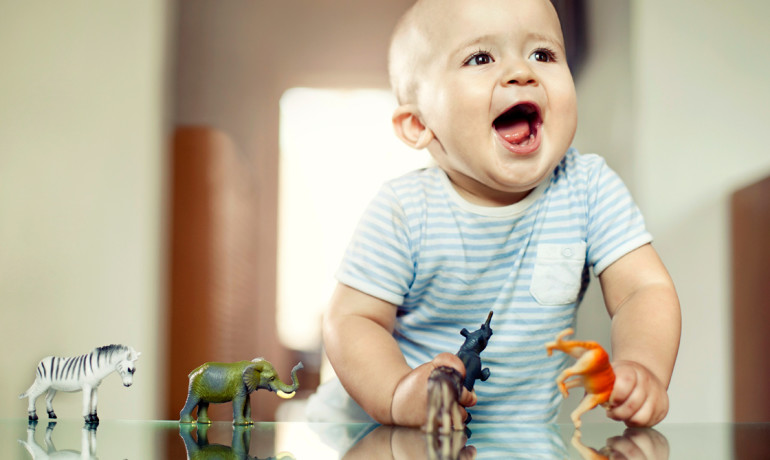A new study is the first to link an early social behavior called gaze shifting with infants’ ability to learn new language sounds.
Babies learn language best by interacting with people rather than passively through a video or audio recording, but it’s been unclear what aspects of social interactions make them so important for learning.
Babies about 10 months old who engaged in more gaze shifting during sessions with a foreign language tutor showed a boost in a brain response that indicates language learning, according to the study, which appears in Developmental Neuropsychology.
“Our study provides evidence that infants’ social skills play a role in cracking the code of the new language,” says coauthor Patricia Kuhl, co-director of the Institute for Learning & Brain Sciences (I-LABS) at the University of Washington.
“We found that the degree to which infants visually tracked the tutors and the toys they held was linked to brain measures of infant learning, showing that social behaviors give helpful information to babies in a complex natural language learning situation,” Kuhl says.
GAZE SHIFTING
Gaze shifting, when a baby makes eye contact and then looks at the same object that the other person is looking at, is one of the earliest social skills that babies show.
“These moments of shared visual attention develop as babies interact with their parents, and they change the baby’s brain,” says coauthor Rechele Brooks, research assistant professor at I-LABS.
In an earlier report, Brooks and others showed that infant gaze shifting serves as a building block for more sophisticated language and social skills as measured in preschool children.
“Since gaze shifting is linked to a larger vocabulary in preschoolers, we suspected that eye gaze might be important earlier when babies are first learning the sounds of a new language, and we wanted to use brain measures to test this,” Brooks says.
LEARNING SPANISH AT 9.5 MONTHS
In the experiment, 9.5-month-old babies from English-speaking households attended foreign language tutoring sessions. Over four weeks, the 17 infants interacted with a tutor during 12 25-minute sessions. The tutors read books and talked and played with toys while speaking in Spanish.
At the beginning and end of the four-week period, researchers counted how often the infants shifted their eye gaze between the tutor and the toys the tutor showed the baby.
After the tutoring sessions ended, the researchers brought the babies back to the lab to see how much Spanish the babies had learned. This was measured by their brain responses to English and Spanish sounds. The babies listened to a series of language sounds while wearing an electroencephalography (EEG) cap to measure their brain activity.
The results showed that the more gaze shifting the babies participated in during their tutoring sessions, the greater their brain responses were to the Spanish language sounds.
‘THEY’RE PAYING ATTENTION’
“Our findings show that young babies’ social engagement contributes to their own language learning—they’re not just passive listeners of language,” Brooks says. “They’re paying attention, and showing parents they’re ready to learn when they’re looking back and forth. That’s when the most learning happens.”
The study builds on earlier work by Kuhl’s team, which found that babies from English-speaking households could learn Mandarin from live tutors, but not from video or audio recordings of Mandarin and from other work at I-LABS establishing the importance of infant eye gaze for language learning.
The researchers hope their findings help parents, caregivers, and early childhood educators develop strategies for teaching young children.
“Babies learn best from people,” Brooks says. “During playtime your child is learning so much from you. Spending time with your child matters. Keeping them engaged—that’s what helps them learn language.”
Lead author of the paper is Barbara Conboy of the University of Redlands, who did the research as a postdoctoral fellow at I-LABS. Andrew Meltzoff, co-director of I-LABS, is also a coauthor.
Fuente: www.futurity.org
